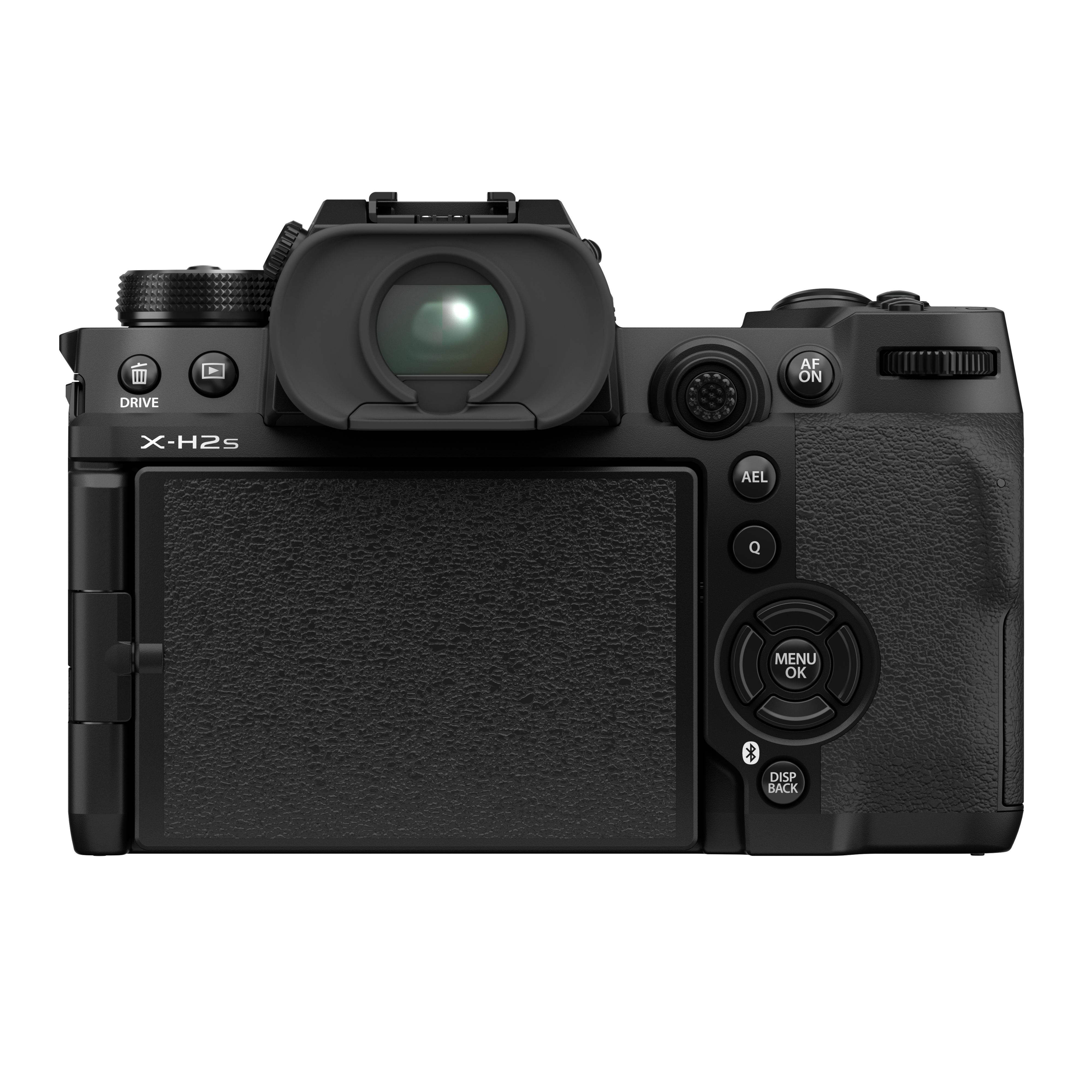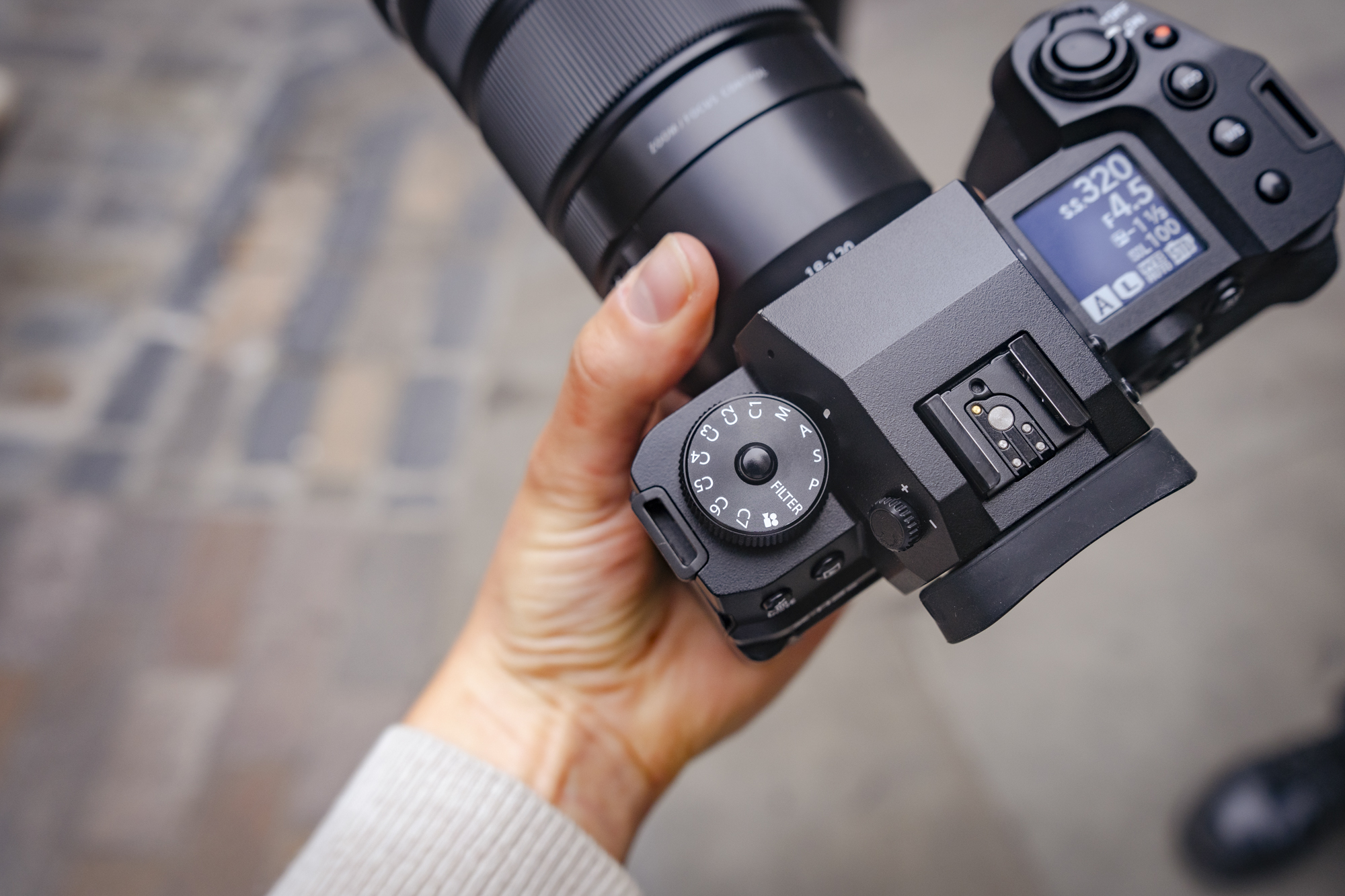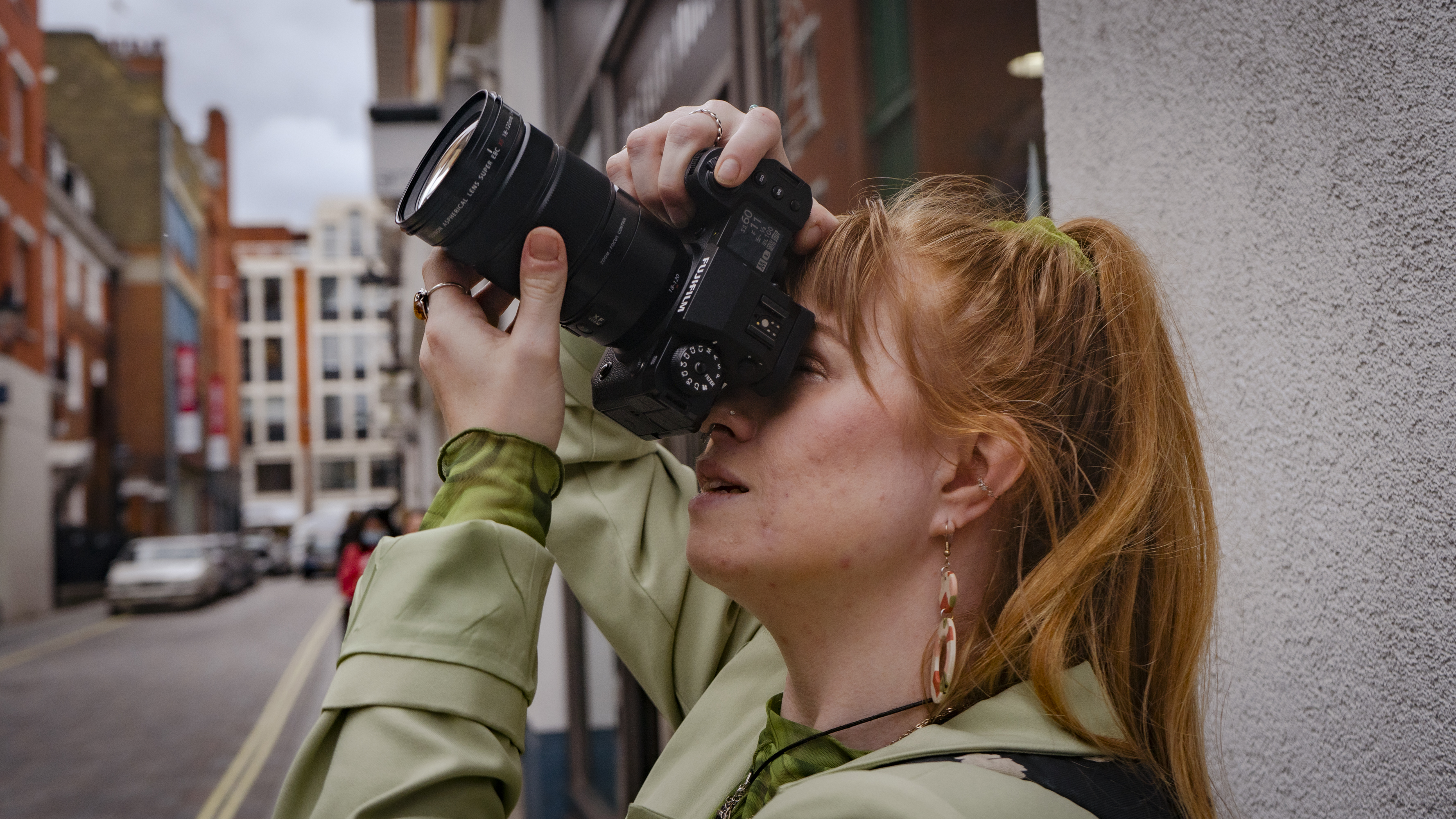Digital Camera World Verdict
The Fujifilm X-H2S boasts the highest performance for stills and videos in the history of the X Series. With double the processing power of its predecessor, it offers a class-leading 40fps continuous shooting with full autofocus functions. The video specs are spectacular at 6.2K 30p uncropped, and with the option of three Apple ProRes codecs. For sports photographers, bird enthusiasts and users who do a lot of on-location work and don't want the size or price of a full-frame sensor, the Fujifilm X-H2S is a terrifically powerful companion.
Pros
- +
Up to 7 stops of stabilization
- +
Continuous shooting at 40fps
- +
6.2K 30p and 4K 120p video
Cons
- -
No eye Control AF
- -
May need optional cooling fan
Why you can trust Digital Camera World
The Fujifilm X-Summit is always full of surprises, and the company used its most recent global event to announce the Fujifilm X-H2S. With it was the announcement of a brand-new fifth generation sensor and processor, the X-TransTM CMOS 5 HS and X-Processor 5 respectively. With the X-H2S, Fujifilm looks to have created a camera that high-speed photographers of sports, wildlife and action should love – and be well served by.
We gave the Fujifilm X-H1 top marks when it was released more than 4 years ago, and we couldn't help but give the Fujifilm X-T4 a five-star review back in 2020 (see our Fujifilm X-H2S vs X-T4 comparison). But does the Fujifilm X-H2S do enough to warrant its place as the manufacturer's latest flagship? And, since we're wondering, does it outsmart competitors such as the OM System OM-1?
The Fujifilm X-H2S is certainly one of the best professional cameras you can buy. Its continuous shooting speed using the electronic shutter is a staggering 40fps – that's 10 to 20 fps faster than any full-frame stacked sensor camera currently on the market, including the Canon EOS R3 the Sony A1 and the sports-centric Nikon Z9.
Thanks to the rumor mill surrounding Fujifilm's May 2022 X-Summit event, we thought we were getting a 40MP Fujifilm X-H2 (we now learn that's coming later in 2022) but the X-H2S surpasses many of our expectations – especially when it comes to its impressive video specs. We'll delve into these more below, but needless to say that 10bit video at 6.2K 30p and 4K 120p internally, the addition of three Apple ProRes codecs, and an improved sensor readout speed during video recording (to suppress rolling shutter effects) are all things that serious video creators will look for.
Fujifilm is a bit late to the high-speed party, having traditionally aimed its cameras squarely at the lifestyle end of photography – think food, portrait and travel. However, the manufacturer might now have done enough to be considered a serious contender among those who rate speed as a priority when it comes to choosing a camera. And to be honest, speed aside, the the Fujifilm X-H2S is a brilliant camera in its own right – both for stills and video.






Specifications
Sensor: 26.1MP 23.5mm x 15.6mm (APS-C) X-Trans CMOS 5 HS
Image processor: X-Processor 5
Mount: Fujifilm X-mount
ISO range: 80 to 51,200
Shutter: 30 secs to 1/8000sec.
Image stabilization: 5-axis IBIS
Max image size: 6,240 x 4,160
Max video resolution: 6.2K 30p, 4K 120p, 1080 240p
Viewfinder: 5.76-million-dot OLED
Memory card: 2 x CFexpress Type B/SD UHS-II cards
LCD: Vari-angle touchscreen, 1.62m dots
Max burst: 40fps electronic, 15fps mechanical
Connectivity: Wi-Fi, Bluetooth, HDMI, USB-C
Size: 136.3 x 92.9 x 84.6mm
Weight: 579g (body only)
Key features
Aimed at pro photographers who need high-speed performance for tracking wildlife, sports or action, the Fujifilm X-H2S is designed to pack all the features that a photographer could want or need when shooting at a race track or tucked away in a bird hide. It's also a powerful machine, catering to the diverse needs of the modern content creator as well as hybrid shooters.
The best camera deals, reviews, product advice, and unmissable photography news, direct to your inbox!
At the heart of the camera is a brand-new X-Trans CMOS 5 HS sensor. It has a signal readout speed that's roughly four times faster than the Fujifilm X-T4 but the same 26.1MP resolution. The sensor has a stacked-layer structure, and this is what enables the photographer to achieve blackout-free continuous shooting up to a sort-of-ridiculous 40 frames per second. By comparison, the flagship Nikon Z9 and Sony A1 both max out at 30fps continuous shooting when using the electronic shutter. You'll actually get over 1,000 frames when setting the high-speed burst shooting mode to 30 frames per second in JPEG, or 20 frames per second in RAW mode.
To keep up with such speed, the camera features dual memory card slots now supporting CFexpress Type B and SD UHS-II cards, as CFexpress Type B cards can process high-speed data – allowing the H2S’s fast continuous shooting and video performance to reach its full potential. The Fujifilm X-H2S also shoots 10 bit HEIF (High Efficiency File Format) files, which are more efficient than JPEGs when it comes to storage space and capturing greater color depth.
In terms of autofocus, Fujifilm says that an "improved prediction algorithm for AF" has led to a big boost in the X-H2S's ability to track a moving subject. The camera uses an Intelligent Hybrid AF system (a mix of through the lens contrast and phase detection). Continuous autofocus is absolutely imperative for sports and wildlife photographers whose subjects often move erratically, and the processor now features subject-detection AF that's been developed with Deep Learning technology to improve tracking in Continuous AF mode.
This autofocus system can lock onto a myriad of subjects such as faces, animals, birds, bikes, planes, cars and trains. The aim is that the photographer can focus on the creativity of the shot and the composition while the AF system will keep things sharp. It's worth pointing out that with the AI learning, the camera uses information from a massive database and doesn't actually learn from the user, but obviously that's something that Fujifilm has the potential to update over time.
When it comes to video, the Fujifilm X-H2S represents a potentially massive upgrade for pros. The new sensor/processor combo enables recording of 10bit video at 6.2K 30p, as well as high-speed 4K/120P video which will allow fast-moving subjects – birds, planes, runners – to be captured in slow-motion.
What's more, the Fujifilm X-H2S supports three Apple ProRes codecs; ProRes 422 HQ, ProRes 422, and ProRes 422 LT. If you're not familiar with Apple ProRes and why it's important for many pros, it essentially streamlines the overall workflow from shooting to editing, as it's a more efficient codec.
F-Log2 capability is another new video feature on the camera, which preserves up to 14+ stops of dynamic range from the camera sensor.
In recent years the phenomenon of mirrorless cameras overheating and limiting video recording has been a notorious and even amusing source of contention, so what about maximum recording times? Well the Fujifilm X-H2S has been designed with a built-in heat-dissipating structure which increases the maximum video recording time to 240 minutes of 4K/60P video. This is only the quote for reasonable temperature climates, and to ensure longer video recording in high-temperature conditions, photographers will probably have to buy and attach Fujifilm's new optional cooling fan (catchily named FAN-001) which extends the video recording further – priced at $199/£169.
Accessories
The Fujifilm X-H2S has been released with several optional add-on accessories that could definitely enhance the shooting experience – depending on your genre of photography. These include a Vertical battery grip (VG-XH) that fits two high capacity batteries, and File transmitter (FT-XH) due to be released in Sep 2022, which features wired LAN connectivity and high-speed wireless communications capability.
There's also the cooling fan (FAN-001) that we mentioned earlier, which has been designed exclusively for the the Fujifilm X-H2S to allow it to record continuously for longer in high temperatures without shutting down. This small and portable fan clips onto the back of the camera body without cables, and it runs off the camera's battery.
Build and handling
In many ways the X-H2S feels similar to the Fujifilm X-H1 when it's in your hand. However it is slightly smaller, even though it uses a bigger battery with a capacity up to 720 frames in economy mode – a full day, in other words. It features a chunky and pleasing grip that works well to give you a secure hold even in smaller hands. Just like its predecessor, it has a monochrome LCD display on the top panel that displays at a glance the key exposure settings and camera modes.
Fujifilm has taken on board feedback from its users and made some small but welcome changes that enhance handling, refining the modes and dials to improve operability. Some the switches and dials from the X-H1 have been removed entirely, so that you're more reliant on the custom buttons for control, but this leads to a less cluttered design – where everything you need feels accessible and sensibly placed.
For example, the focus select switch has now gone, and a function button is in its place. The actual dials themselves feel more robust and nicer to press, and half-pressing the shutter button is so much smoother. Even the eyelets on the top plate have changed so that you can now fit larger straps on the camera.
One obvious change is the addition of a dedicated record button on the top of the camera plate next to the shutter. This – alongside the 1.62-million-dot vari-angle LCD touchscreen – could cement the Fujifilm X-H2S as a more than decent hybrid camera.
Performance

Sample images gallery

Sample images gallery

Sample images gallery

Sample images gallery
The first thing you noticed about the Fujifilm X-H2S is how tactile it is, and how enjoyable the handling. The slightly larger grip allows you to grab onto it comfortably even when using it with very long lenses such as the new Fujifilm XF150-600mmF5.6-8 lens (which was announced at the May 2022 X-Summit at the same time).
As well as a street photography session around London's Covent Garden, we got the opportunity for some action photography and video at the Goodwood Festival of Speed, where the frankly phenomenal burst speed wowed us most of all.
The effective in-body image stabilization and, where available, lens stabilization too, makes it much easier to get sharp shots handheld from a static position. Our panning experiments worked out pretty well too, and while even with subject detection enabled the X-H2S didn't offer a 100% hit rate, it did enable a good percentage of sharp shots at very slow panning speeds.
Here's some sample video we shot at the Goodwood Festival of Speed (thanks, Fujifilm).
The stabilization comes into play for video shooting too, and here the X-H2S demonstrated very effective static stabilization but did produce more mixed results with panning movements. We've seen this many times before with in-body stabilization systems – the technology is great when the camera is still, but not so effective with deliberate camera movements. The X-H2S seems to do a kind of occasional 'jump-reset' with its stabilizer that we've seen with the X-S10 too.
Although we know that the name of the game with the Fujifilm X-H2S is speed, it also handled portraits well. Fujifilm is well known for its color science and color profiles, and the camera rendered skin tones accurately and smoothly.
Thanks to the 5-axis in-body image stabilization, we found that we were able to capture sharp handheld shoots indoors and as the weather turned grim, so we'd likely have no qualms about taking the camera on a low-light shoot without a tripod – especially given the ISO capabilities of up to 51,200.
Fujifilm X-H2S: Lab results
For our lab data comparison, we compared the X-H2S to rival cameras which are strong performers for both still and video shooting, as well as being capable of fast burst shooting. Given that the price of the Fujifilm puts it in the realms of full-frame camera territory, we've included two full-frame cameras in the comparison.
We test resolution using Imatest charts and software, and dynamic range and signal to noise ratio with DxO Analyzer.
Resolution:
Resolution is measured using standardized text charts which give results in line widths / picture height, which is independent of sensor size. We chose three rivals based on price and broad capabilities – the full frame Canon EOS R6 and Nikon Z6 II, and the APS-C Sony A6600.
The results here are broadly in-keeping with each camera's sensor resolution, with the R6 resolving slightly less detail than the Nikon, and the 26.1MP X-H2s coming out on top. The surprise performer is the 24MP A6600, which manages to equal the Fujifilm's resolving power at lower sensitivities, and even resolve more detail at higher ISOs.
Dynamic range:
Dynamic range is a measure of a camera's ability to record extreme brightness ranges and still retain detail in the brightest and darkest parts of the scene. It's measured in EV (exposure values, or 'stops').
At lower sensitivities, the X-H2S can capture an almost identical amount of dynamic range as the EOS R6 and Z6 II, which both have full frame sensors. It remains level-pegging with Canon right through our tested ISO range, though the Nikon manages to record as much as 1EV broader dynamic range at ISO 6400 and above. The A6600 has an older sensor design and can't match the other three cameras for dynamic range across the ISO scale.
Signal to noise ratio:
The X-H2S has the highest resolution in this group and is also up against two full frame cameras, so it does well to stay only slightly behind for noise. The A6600 trails by some margin.
Verdict
We've now been able to spend some time with a production version of the X-H2S and it's clear that Fujifilm's new flagship will be an excellent choice for pros who are keen to stick with the APS-C format but want a camera that breaks new speed barriers – all without breaking the bank. It's not cheap for an APS-C model, but it is when you put it against comparable full frame models.
The other key factor is that Fujifilm has built a very convincing array of lenses for all manner of photographic genres – including pro sports photography – and in the APS-C market only Sony has come close to matching that. And Sony's best APS-C camera, the A6600, is no match for the Fujifilm X-H2S.
The initial price point is around $2499/£2499, which is a touch more than some of the best hybrid cameras and the much-loved Fujifilm X-T4, one of (in our opinion) the best APS-C hybrid cameras ever made, but the performance and capabilities of the X-H2S easily justify that price tag.
If you already shoot with the Fujifilm X-H1 or Fujifilm X-T4, you might not find enough of a reason to upgrade to the H2-S just yet unless your work involves shooting fast subjects (in which case the X-H1 might not be the best choice anyway).
But if you want to experience the latest and greatest Fujifilm X-series flagship and potentially future-proof yourself with a stills and video camera that will last for many years to come, the Fujifilm X-HS2 looks to be a very good buy indeed, especially if you're already an X-system user looking for the next step up.
Read more:
Fujifilm X-T4 review
Fujifilm X-H2 vs X-T4
The best Fujifilm camera
The best Fujifilm lenses

Lauren is a writer, reviewer, and photographer with ten years of experience in the camera industry. She's the former Managing Editor of Digital Camera World, and previously served as Editor of Digital Photographer magazine, Technique editor for PhotoPlus: The Canon Magazine, and Deputy Editor of our sister publication, Digital Camera Magazine. An experienced journalist and freelance photographer, Lauren also has bylines at Tech Radar, Space.com, Canon Europe, PCGamesN, T3, Stuff, and British Airways' in-flight magazine. When she's not testing gear for DCW, she's probably in the kitchen testing yet another new curry recipe or walking in the Cotswolds with her Flat-coated Retriever.
- Rod LawtonContributor
- Hannah RookeFreelance contributor
- Niall HamptonEditor
















